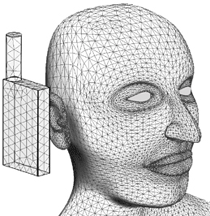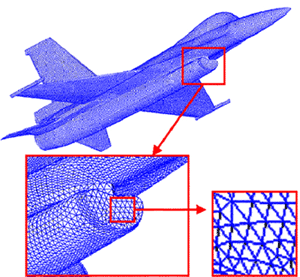 The Bilkent University
Computational Electromagnetics Research Center (BiLCEM) is an excellence center that is
dedicated to the study of the solution of real-life electromagnetics problems using
cutting-edge computing technologies. Applications involve radars, antennas,
nanostructures, metamaterials, microelectronics, optics, mobile phone systems, etc. These
complicated problems require the numerical solution of extremely large matrix equations.
For example, the F-16 fighter illustrated in the picture (page 2) is modeled with millions
of triangles. BiLCEM researchers develop fast solution techniques to solve such large
problems. They also use high-performance computers and construct parallel computing
platforms to satisfy the high computational requirements needed for the solutions of
millions of unknowns. BiLCEM studies are supported by TÜBİTAK, TÜBA, Aselsan, and SSM. The Bilkent University
Computational Electromagnetics Research Center (BiLCEM) is an excellence center that is
dedicated to the study of the solution of real-life electromagnetics problems using
cutting-edge computing technologies. Applications involve radars, antennas,
nanostructures, metamaterials, microelectronics, optics, mobile phone systems, etc. These
complicated problems require the numerical solution of extremely large matrix equations.
For example, the F-16 fighter illustrated in the picture (page 2) is modeled with millions
of triangles. BiLCEM researchers develop fast solution techniques to solve such large
problems. They also use high-performance computers and construct parallel computing
platforms to satisfy the high computational requirements needed for the solutions of
millions of unknowns. BiLCEM studies are supported by TÜBİTAK, TÜBA, Aselsan, and SSM.
Recently, BiLCEM teamed up with Intel Corporation to achieve the solution of the largest
problem ever solved in computational electromagnetics. Intel made its parallel computing
platforms in England available to the BiLCEM researchers over the Christmas and New Year
holidays. Even though this meant no holiday break for BiLCEMers so that they would not
waste any CPU cycles available to them, they "celebrated the New Year by breaking a
world record," according to Özgür Ergül and Tahir Malas, PhD students at BiLCEM.
They were able to solve a problem with 33 million unknowns, which is reported to be the
largest integral-equation problem ever solved.
 Prof. Levent Gürel, Director
of BiLCEM, welcomed this achievement as a major milestone in the discipline of
computational electromagnetics. The world record will be presented at the upcoming 2007
IEEE International Symposium on Antennas and Propagation, which is the major worldwide
conference on electromagnetics. Prof. Levent Gürel, Director
of BiLCEM, welcomed this achievement as a major milestone in the discipline of
computational electromagnetics. The world record will be presented at the upcoming 2007
IEEE International Symposium on Antennas and Propagation, which is the major worldwide
conference on electromagnetics.
Breaking the world record will enable BiLCEM researchers to solve larger and more
meaningful real-life problems. One example is the imaging of electromagnetic fields in
biological systems. Investigating the interaction of electromagnetic radiation with living
organisms, such as the influence of cell phones on the human brain (see picture), has
become a vital issue for humanity. Since measurement methods in living bodies are
extremely limited, computational simulations carried out at BiLCEM are of the utmost
importance. Another example is the humanitarian effort of detecting landmines buried under
ground. For this purpose, powerful electromagnetic solvers are developed at BiLCEM.
Exactly the same solvers can also be utilized for the microwave imaging and detection of
tumors hidden inside the human body. Yet another area explored by BiLCEM researchers is
the electromagnetic modeling of complicated nano-optical imaging systems involving laser
beams, lenses, and chips of nanostructures.
Students, who would like to obtain scholarships by participating in exciting BiLCEM
projects on parallel computers, programming, and computational electromagnetics, may
contact Prof. Levent Gürel (lgurel@bilkent.edu.tr).
No prior experience is required. No prerequisites!

|







